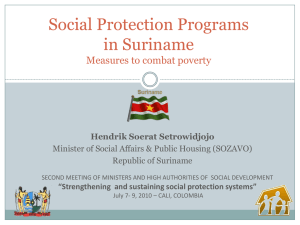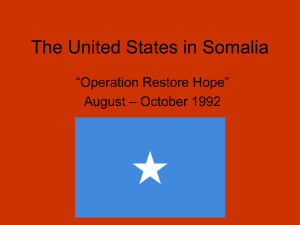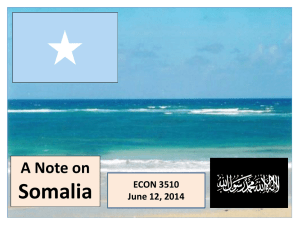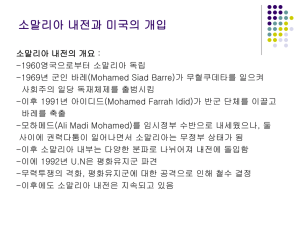Poverty Eradication Strategies for Food Security and Democracy
advertisement
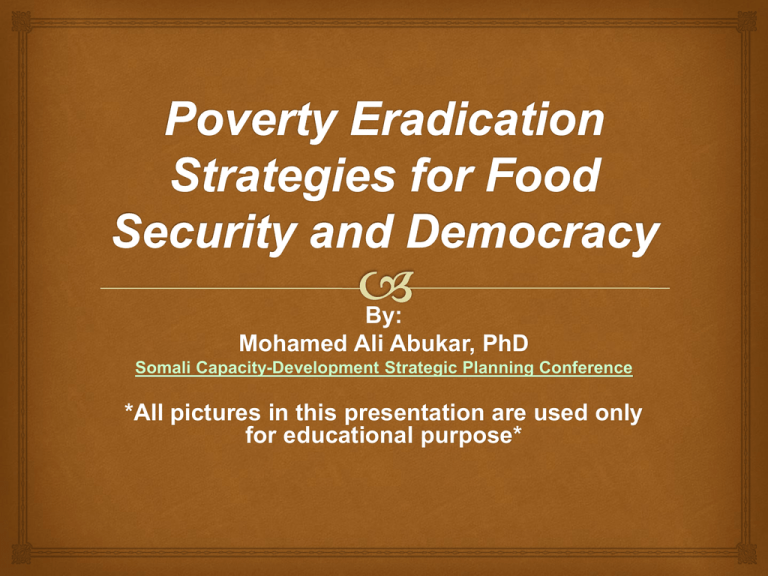
By: Mohamed Ali Abukar, PhD Somali Capacity-Development Strategic Planning Conference *All pictures in this presentation are used only for educational purpose* Poverty Poverty is a fuel for terror, and a: Threat to: Human Rights Democracy Peace Dimension of poverty that are considered in any assessment are: Income Lack of Education Health Democracy and Human Rights All are combined in so-called human Development. Peace, stability and democracy cannot be achieved when there is hunger and poverty. Growth of the Agricultural Sector This will largely depend on growth of crop production and will be obtained in focusing investment in Research and Extension. Somalia needs development plans that prioritize agriculture to the center of economic growth, and encourage investment in the agricultural potential areas. Good governance is essential for good economic growth. To achieve a sustainable rural development its necessary to lay a foundation for long term development. Cause of Slow Growth Political Instability Civil War Low Priority to food production Low status of women Droughts & Decertification Poor governance and greed of power Limited purchasing power. Tribalism and Religious extremists have fueled interconflict and struggle for internal power in Somalia. Overcoming Constraints Best strategy is to promote: Sustainable development Small scale farmers and innovative agricultural practices Community capacity building Institutional building Efficient technology development and transfer institutions. Somalia’ small-scale farmers needs reform, and they can be a real asset when supported by appropriate policies on infrastructures, marketing information, credit, research, extension and access to inputs. Improving linkage mechanisms and reorganizing research and extension institutions will improve effectiveness in focusing a shared goal and partnership with beneficiaries. Improving Farmers Life In Somalia, poverty levels are growing and people are fleeing the agricultural potential areas and heading toward the main cities and abroad, where they hope to get a better life. Helping farmers to grow more food and develop their knowledge, educating them to build basic thinking abilities will certainly improve their life and keep them in the agricultural potential villages. To eliminate rural poverty it is necessary to build upon and connect several principles, such as: Market functioning, rural education, health, clean water, participatory approach, decentralization and family’s income. Eradicating Poverty Our focus, is to fight hunger and eradicate poverty, which will certainly lead to the creation of peace, democracy and good will among all people and nations. The overall concept for world poverty is the number of people who live in households whose daily consumption per head is less then one US dollar per day. Innovative policies that ensures educational and health facilities to become a reality for the vast segment of the population that has yet to enjoy such benefits. Measuring Domestic Poverty To measure domestic poverty we must consider: House Income Education Health Market Road Technologies Non-Formal Education Improving the education system will increase the basic conditions for sustainable Development, food security and a democratic system. Successful method of non-formal education is the participatory approach. Extension may be seen as a form of Adult education and try to change farmers behavior through education and communication. This process will help in reducing and alleviating poverty and accelerating development. Project Formulation In Somalia most development programs are formulated, and appraised by outside expert. Lack of involvement or insufficient community participation will certainly result in many cases in the failure of the program. In order to succeed, beneficiaries and all involved institution must participate at every stage of the program planning. Land Somalia’s land is about 64 Million Hectares About 29.9 Million hectares are classified as AP areas About 200,000 hectares along the rivers benefit from largely seasonal flood and proper irrigation system. Somalia’s most reliable crop production comes from the irrigated or seasonally flooded lands. Rain-fed crop production, oftentimes fails due to frequent drought conditions. Developing Technologies The United States leads the world in agricultural productivity, and this success depends in part with the American infrastructures for generating and disseminating appropriate and useful technologies. Many international development aid and agencies have set up their base in Somalia to help in reducing and eradicating poverty. This process is certainly going to help in reducing hunger, accelerating food security, which will create constructive and enduring contribution toward peace, democracy and prosperity. Farming System The role of extension service as an educational activity is a key to all social and cultural factors that affects how farmer will choose the appropriate farming system. The main way to improve Farming system and to increase production is to educate farmers. Extension involves the use of communication to help form sound opinion and make proper decision, and implies a two way flow of technical information. Participatory Approach Participatory approach is social mobilization, which includes local organization development action planning and evaluation of the action by the people involved in the process. The participatory approach, means strengthening mechanism for joint learning and sharing of experiences and communication. The immediate impact is spreading technologies and improving the self-governance of the community. Good technologies will encourage the community to become the only people who can make effective decisions about how to manage their own affairs. People Empowerment A good Model Is To Show And Teach People How To Fish Rather Than Just Giving Them A Fish. Experience teaches that a well organized and dynamic community characterized by freedom and democracy will certainly give a top priority to sustainable development. Rural Women Somalia being a male dominated Society Men are seen as authority figures and whose decisions are to be followed. Rural Women are shy and reluctant to speak up in meetings in the presence of men. They also lack of confidence because lower educational levels and less contact with the outside world. Needs reform to enhance their capabilities. Illiteracy should be reduced to the lowest level, and literacy of women should reach the highest level. Study on relative female efficiency A study on the relative efficiency of female and male farmers concluded that maize yields for women small holders were 7% more then men with the same access to extension services, inputs and education. Women are responsible for 70% of food production in Africa. Capacity Building Capacity building and institutionalizing must be closely linked and should be considered a priority. Educational Institutions should take a lead role in developing appropriate strategies and activities to build capacity. The adoption of the recommended technologies and practices will lead to increase domestic and national production, economic development and will improve beneficiaries living conditions. Major Obstacles In Somalia and in many developing countries lack of: Access to rural credit facilities Lack of capital Poor physical Market Infrastructures Health care, Peace & Stability Proper Education Scarcity of improved planting material All were identified as a major obstacle for achieving self-sufficiency on food. Democracy & Hunger We all certainty agree that Democracy and hunger cannot go together. Therefore, we can strongly affirm that there can be no place for hunger and poverty in a modern world in which science and technology have created conditions for equitable Development. This will improve sustainability to increase food production, assuring freedom from fear and basic foods for all people at all times Somalia 1980-1991 prior to the civil war. Worked in the government as a civil servant (A1) Chairman of National Production & General manager of the largest Agricultural Extension, training and Farm Management Project in Somalia. Establishment of AFMET( Agricultural Farm Management Extension Training Project) Main objective was to increase agricultural production and farmer income. Agricultural Farm Management Extension Training Project Establishment of a farm extension service, dissemination of modern management techniques and enhancing institutional capacity, that have supported agriculture development in Somalia, which is an integral part of the national economic development. Science based agricultural research and establishment of 4 Agricultural secondary Schools, and FMETC. Established 9 regional extension training centers, improved facilities at the training centers, increased and improved training courses expanding field trials program, supported by provision of teaching aids, equipment and technical assistance. Agricultural Extension Service Contributed to a change in attitude toward scientific based farming systems. Changed Farmers behaviors Increased optimism in the farming system. The desire for more investment among the farmers community. Designed and properly implemented activities that bring women into the main focus agricultural operations. EFFECTIVE EXTENSION SYSTEM Established and effective extension system that works with more than 200,000 farm families with the possibilities of meeting every fortnight round a year. Documented increase of agricultural production. Increase in the income of the small-scale farmers. AFMET bestowed Somalia with new technology and innovation in small scale farm production. Benefits of a committed, experienced and well trained cadre of agricultural extension workers. Achieved Success A pilot program for community development and seasonal credit facilities was successfully established in several irrigated and rain-fed areas covered by the project. AFMET designed and implemented community participatory in technology verification & transfer, in both irrigated and rain-fed areas. The yield of Maize and Sorghum as the main Somalia’s food have increased by 45%. Rice farming was introduced and expanded, and the yield reached 5 tons per hector. Achieved Success Intercropping for more crop varieties and crop rotation has been introduced. Animal tractions, agro-forestry, beekeeping, home gardening were also introduced. In conclusion, during the Project cycle (Phase 1 & 2) I worked hard to try to move Somalia toward selfsufficiency with regards to food security. Plan to make Somalia Recover In 1991 when the civil war began, the government collapsed and the country quickly dissolved into a state of lawlessness. Then AFMET Project’s was reversed and most of the infrastructures were destroyed or looted. Well-trained staff fled the country and dispersed throughout the region and they can still be a good resource of information and advice on possible initiatives that may be planned to make Somalia rebuild and recover.

